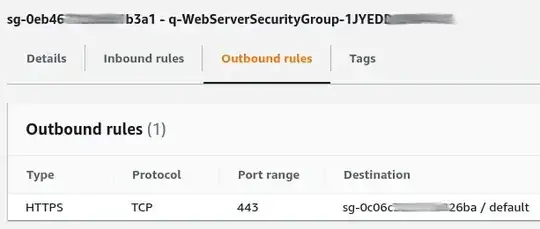I would like to apply port 443 outbound rule to the 'Default' security group. It worked by creating a dedicated block OutboundRule (which is commented out). Instead of creating a new block, I want to apply the rule in the WebServerSecurityGroup resource itself by referencing the VPC.defaultsecuritygroup under second SecurityGroupEgress block. But, it is not working. Would you please suggest me how to make this work.
---
AWSTemplateFormatVersion: '2010-09-09'
Description: 'AWS CloudFormation Sample Template VPC_with_PublicIPs_And_DNS: Sample
template that creates a VPC with DNS and public IPs enabled. Note that you are billed
for the AWS resources that you use when you create a stack from this template.'
Parameters:
KeyPair:
Description: Name of the keypair to use for SSH access
Type: String
Name:
Description: Name of the keypair to use for SSH access
Type: String
Default: LinuxMachine
Resources:
VPC:
Type: AWS::EC2::VPC
Properties:
EnableDnsSupport: 'true'
EnableDnsHostnames: 'true'
CidrBlock: 10.0.0.0/16
PublicSubnet:
Type: AWS::EC2::Subnet
Properties:
VpcId:
Ref: VPC
CidrBlock: 10.0.0.0/24
InternetGateway:
Type: AWS::EC2::InternetGateway
VPCGatewayAttachment:
Type: AWS::EC2::VPCGatewayAttachment
Properties:
VpcId:
Ref: VPC
InternetGatewayId:
Ref: InternetGateway
PublicRouteTable:
Type: AWS::EC2::RouteTable
Properties:
VpcId:
Ref: VPC
PublicRoute:
Type: AWS::EC2::Route
DependsOn: VPCGatewayAttachment
Properties:
RouteTableId:
Ref: PublicRouteTable
DestinationCidrBlock: 0.0.0.0/0
GatewayId:
Ref: InternetGateway
PublicSubnetRouteTableAssociation:
Type: AWS::EC2::SubnetRouteTableAssociation
Properties:
SubnetId:
Ref: PublicSubnet
RouteTableId:
Ref: PublicRouteTable
PublicSubnetNetworkAclAssociation:
Type: AWS::EC2::SubnetNetworkAclAssociation
Properties:
SubnetId:
Ref: PublicSubnet
NetworkAclId:
Fn::GetAtt:
- VPC
- DefaultNetworkAcl
WebServerSecurityGroup:
Type: AWS::EC2::SecurityGroup
Properties:
GroupDescription: Enable HTTP ingress
VpcId:
Ref: VPC
# Apply outbound rules to ec2 security group
SecurityGroupIngress:
- IpProtocol: tcp
FromPort: '80'
ToPort: '80'
CidrIp: 0.0.0.0/0
- IpProtocol: tcp
FromPort: '22'
ToPort: '22'
CidrIp: 0.0.0.0/0
SecurityGroupEgress:
- IpProtocol: tcp
FromPort: '443'
ToPort: '443'
CidrIp: 127.0.0.0/0
# WIP - Default Security group
SecurityGroupEgress:
- IpProtocol: tcp
FromPort: '443'
ToPort: '443'
CidrIp: 0.0.0.0/0
GroupId: !GetAtt VPC.DefaultSecurityGroup
# Apply outbound rules to 'Default' Security Group
# OutboundRule:
# Type: AWS::EC2::SecurityGroupEgress
# Properties:
# GroupId:
# Fn::GetAtt:
# - VPC
# - DefaultSecurityGroup
# IpProtocol: tcp
# FromPort: '443'
# ToPort: '443'
# CidrIp: 0.0.0.0/0
WebServerInstance:
Type: AWS::EC2::Instance
Properties:
InstanceType: t2.micro
ImageId: ami-09e67e426f25ce0d7
Tags:
- Key: Name
Value: !Ref Name
NetworkInterfaces:
- GroupSet:
- Ref: WebServerSecurityGroup
AssociatePublicIpAddress: 'true'
DeviceIndex: '0'
DeleteOnTermination: 'true'
SubnetId:
Ref: PublicSubnet
KeyName:
Ref: KeyPair
